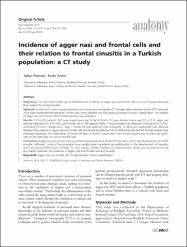| dc.contributor.author | Özdemir, Adnan | |
| dc.contributor.author | Arslan, Serdar | |
| dc.date.accessioned | 2020-06-25T14:46:59Z | |
| dc.date.available | 2020-06-25T14:46:59Z | |
| dc.date.issued | 2018 | |
| dc.identifier.citation | Özdemir, A., Arslan, S. (2018). Incidence of agger nasi and frontal cells and their relation to frontal sinusitis in a Turkish population: a CT study. Anatomy, 12(2), 71 - 75. | en_US |
| dc.identifier.issn | 1307-8798 | |
| dc.identifier.issn | 1308-8459 | |
| dc.identifier.uri | https://doi.org/10.2399/ana.18.050 | |
| dc.identifier.uri | https://app.trdizin.gov.tr/publication/paper/detail/TXpBNE5EazJOZz09 | |
| dc.identifier.uri | https://hdl.handle.net/20.500.12587/1531 | |
| dc.description.abstract | Objectives: The aim of this study was to determine the incidence of agger nasi and frontal cells in a Turkish population andtheir relation to frontal sinusitis.Methods: A total of 412 non-contrast paranasal sinus computed tomography (CT) images taken between March 2017 and June2018 were examined retrospectively. Frontal cells were classified into four types according to Kuhn’s classification. The relationof agger nasi and frontal cells to frontal sinusitis was evaluated.Results: Of the 412 patients, 202 were males (mean age 34.814.9) and 210 were females (mean age 35.113.9). agger nasicell was detected in 214 (51.9%), and frontal cell in 198 patients (48%). Frontal sinusitis was detected in 68 patients (16.5%).According to Kuhn’s classification, Type 1 frontal cell was detected most frequently. A significant relationship was observedbetween the presence of agger nasi and frontal cells and frontal sinusitis (p0.001). When the right and left frontal sinusitis wereevaluated separately, the relationship of frontal cell types of Kuhn’s classification with frontal sinusitis was found to be significant on the right side, but not on the left side.Conclusion: Agger nasi and frontal cells are common paranasal sinus variations that play a role in the development of frontalsinusitis. Although most of the paranasal sinus variationsare considered as predisposing in the development of sinusitis,there are obvious differences in studies. For this reason, a higher number of comprehensive studies are necessary to revealthe relation between the presence of agger nasi and frontal cells and sinusitis. | en_US |
| dc.language.iso | eng | en_US |
| dc.relation.isversionof | 10.2399/ana.18.050 | en_US |
| dc.rights | info:eu-repo/semantics/openAccess | en_US |
| dc.subject | Anatomi ve Morfoloji | en_US |
| dc.title | Incidence of agger nasi and frontal cells and their relation to frontal sinusitis in a Turkish population: a CT study | en_US |
| dc.type | article | en_US |
| dc.contributor.department | Kırıkkale Üniversitesi | en_US |
| dc.identifier.volume | 12 | en_US |
| dc.identifier.issue | 2 | en_US |
| dc.identifier.startpage | 71 | en_US |
| dc.identifier.endpage | 75 | en_US |
| dc.relation.journal | Anatomy | en_US |
| dc.relation.publicationcategory | Makale - Ulusal Hakemli Dergi - Kurum Öğretim Elemanı | en_US |
















